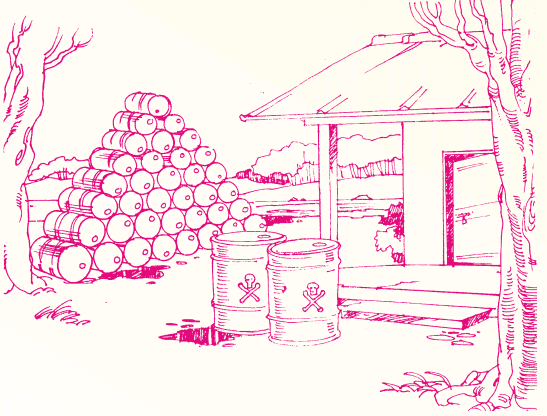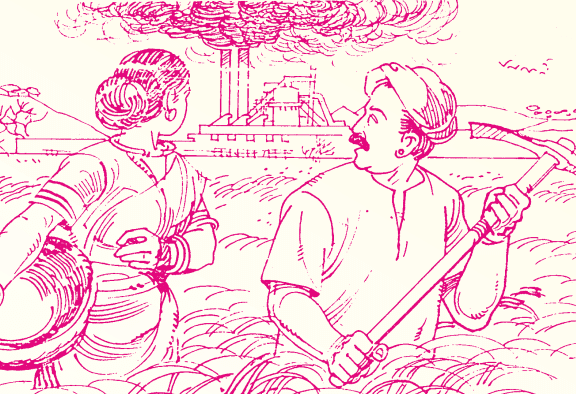A Tale of Three Villages Chapter Notes | Communicative English for Class 10 PDF Download
| Table of contents |

|
| Key Points of the Story |

|
| Detailed Summary |

|
| Theme/ Message |

|
| Difficult Words |

|
Key Points of the Story
- The story begins in Koko Village, Nigeria, where Mr. Sunday Nana lives with his family in a typical African village setting.
- Outside Mr. Nana's house are three large, empty metal drums marked with skull and crossbones, indicating a hazardous substance.
- A large pyramid of similar drums is located near the village, leaking toxic chemicals into the nearby drinking water stream.
- Five years ago, big lorries unloaded these drums in the village, but the villagers were never informed about their contents.
- Mr. Nana mentions that many villagers, including his own brother, have died from illnesses believed to be caused by the chemicals in the drums.
- The villagers have sought help from the government and even contacted Italy, where the chemicals reportedly originated, but received no assistance.
- In Ponnimanthuri Village, India, a woman recalls how factories were built under the promise of jobs and wealth, but they brought pollution instead.
- The factories discharge harmful chemicals into the environment, ruining the fields and causing health problems for the villagers.
- Vijayasama, a villager, lamented that they were misled about the effects of the factories and how their lives changed for the worse.
- In Vorobyov Village, Ukraine, Natasha recounts the tragic events of the Chernobyl disaster, which happened on her mother's birthday.
- Initially, the villagers were unaware of the danger posed by the radioactive dust, and their children played outside, leading to severe health consequences.
- Natasha lost all three of her children due to the effects of radiation, illustrating the devastating impact of environmental disasters.
- The villages in the stories reflect the struggles of communities facing pollution and environmental hazards without adequate support or information.
Detailed Summary
In this chapter, we learn about the lives of families in different villages around the world. Each family faces serious problems caused by pollution and chemicals. Let's talk about each village one by one.
In Koko Village, Nigeria, the lives of Mr. Sunday Nana and his family are deeply affected by the presence of dangerous, leaking metal drums that contain poisonous chemicals from Italy. These drums, which arrived five years ago without proper warnings, have caused the deaths of several villagers, including Mr. Nana's brother, and have led to widespread illness, particularly among children. Despite the villagers' efforts to get help from the government and Italy, no action has been taken. The village is left in a dire situation, with no resources to move away from the contaminated land.

In Ponnimanthuri Village, India, the construction of factories for leather production has brought pollution that harms the land, air, and water. The chemicals from these factories have made it impossible for villagers to grow crops, and many are suffering from health issues like ulcers and sores. Villagers feel betrayed as they were not informed about the detrimental effects of the factories, and now they must travel long distances to find clean water. In Vorobyov Village, Ukraine, a tragic nuclear disaster in 1986 left the village deserted, with many people, especially children, suffering from radiation sickness. Natasha, a former resident, recalls the heartbreaking loss of her children and the devastation caused by the explosion, which has left the fields barren and the village abandoned.

These stories from Koko Village, Ponnimanthuri Village, and Vorobyov Village highlight the devastating impact of environmental disasters caused by negligence and industrial activities. In each case, communities have suffered due to toxic chemicals, pollution, and lack of proper warnings or support from authorities. The people in these villages face not only health crises but also deep emotional scars from the loss of loved ones and the destruction of their homes and livelihoods. These tragedies serve as a stark reminder of the importance of environmental responsibility, timely intervention, and the need to prioritize the well-being of communities over short-term economic gains.
Theme/ Message
- The main theme of the stories is the impact of industrial pollution and environmental neglect on human lives and health.
- Another important theme is the betrayal of communities by authorities and corporations who prioritize profit over people's well-being.
- The message conveyed through these stories is that communities need to be informed and protected from harmful practices that endanger their lives.
- There is a call for greater accountability from governments and corporations to ensure the safety and health of the people affected by industrial activities.
Difficult Words
- Hazardous: Dangerous or risky, likely to cause harm.
- Toxic: Poisonous; capable of causing injury or death.
- Corroded: Damaged by chemical action, typically leading to decay or deterioration.
- Explosive: Capable of causing an explosion; sudden and violent.
- Radiation: Energy emitted in the form of waves or particles, which can be harmful to living beings.
- Pollution: The presence of harmful substances in the environment that can cause damage or harm.
- Evacuated: To remove someone from a dangerous place; to leave an area for safety.
- Illness: A disease or period of sickness affecting the body or mind.
- Contaminated: Made impure by exposure to or addition of a poisonous or polluting substance.
- Discharge: To release something, often referring to waste or harmful substances into the environment.
- Community: A group of people living in the same area or sharing common interests.
- Chemical: A substance that has a defined composition and properties, often used in manufacturing.
- Exposed: Made visible or vulnerable to something harmful or dangerous.
- Livelihood: A means of securing the necessities of life, such as a job or income.
- Destruction: The act of causing severe damage or ruin to something.
|
8 videos|250 docs|8 tests
|
FAQs on A Tale of Three Villages Chapter Notes - Communicative English for Class 10
| 1. What are the main themes explored in "A Tale of Three Villages"? |  |
| 2. How do the three villages differ in their approach to problems? |  |
| 3. What is the significance of the title "A Tale of Three Villages"? |  |
| 4. Can you explain the character development in the story? |  |
| 5. What lessons can readers take away from "A Tale of Three Villages"? |  |















